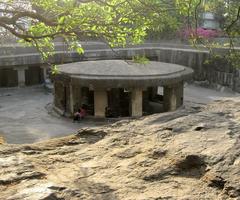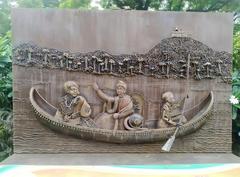
Rajgad Fort: Visiting Hours, Tickets, and Historical Sites in Pune
Date: 03/07/2025
Introduction
Rajgad Fort, lauded as the “King of Forts,” towers above the Sahyadri mountain range, approximately 60 kilometers southwest of Pune. Revered for its pivotal role in Maratha history, remarkable architecture, and breathtaking vistas, Rajgad offers a unique blend of heritage, adventure, and nature. Whether you are a history enthusiast, trekker, or a cultural explorer, Rajgad Fort provides an enriching experience that captures the essence of Maharashtra’s glorious past (edvnce.com, travellersofindia.com).
Historical Overview and Cultural Significance
Ancient Origins
Rajgad traces its roots to the 11th century, originally known as Murumbdev under the Yadava dynasty. Its strategic position—perched at an elevation of about 1,400 meters (4,600 feet)—made it a coveted stronghold for successive rulers in the Deccan region (edvnce.com). The fort’s natural defenses and commanding views laid the foundation for its future prominence.
Role in the Maratha Empire
Chhatrapati Shivaji Maharaj, founder of the Maratha Empire, recognized the fort’s potential and transformed it into his capital in the 17th century. For nearly 26 years (1648–1674), Rajgad served as the nucleus of Maratha administration, strategy, and culture. Notable events include the birth of Shivaji’s son, Rajaram, and the passing of his mother, Jijabai, within the fort’s walls (travellersofindia.com).
Architectural Marvels
Rajgad’s vast expanse—spanning approximately 40 km at its base—features remarkable military architecture:
- Bale Killa (Citadel): The highest point, serving as the royal residence and the fort’s ultimate line of defense.
- Machis (Plateaus): Three principal plateaus—Padmavati, Sanjeevani, and Suvela Machi—each with unique defensive and residential functions.
- Gates and Bastions: Robust gateways (Maha Darwaza, Pali Darwaza, Chor Darwaza) and bastions like Sutara and Kaleshwari Buruj exemplify sophisticated fortification.
- Water Cisterns: Ingeniously carved reservoirs such as Padmavati Tank ensured year-round water supply (Wikipedia).
Cultural Heritage
The fort is a focal point for local festivals, especially Shivaji Jayanti, and serves as a site of pilgrimage and community pride. Traditional celebrations, music, and cuisine bring the fort’s storied past to life (edvnce.com).
Enduring Symbolism
Today, Rajgad stands as a symbol of Maratha valor, strategic acumen, and cultural identity. Its preservation as a heritage site fuels ongoing interest in Maharashtra’s history and inspires modern generations (travellersofindia.com).
Planning Your Visit: Hours, Tickets, and Access
Visiting Hours
- Open Daily: 6:00 AM to 6:00 PM
- Recommended Timing: Early mornings for cooler weather and sunrise views (tripoto.com)
Ticket Information
- Entry Fee: ₹10–25 per person for Indian nationals; ₹100 for foreign nationals. Fees are collected at entry points in Gunjavane or Pali (tripoto.com).
- Children under 12: Free
- Tickets: On-site purchase, cash only. No online booking currently available.
How to Reach
- By Road: Accessible via private vehicle, taxi, or MSRTC bus from Pune to base villages (Gunjavane or Pali), followed by a trek.
- By Train: Pune Junction is the nearest major railway station.
- By Air: Pune International Airport is most convenient; continue by road to the base (samayutravel.com).
Trekking Routes
- Gunjavane (Padmavati Machi): 4.5 km, moderate to difficult, 2.5–4 hours
- Pali (Chor Darwaja): 5 km, moderate, 3–4.5 hours
- Bhor (Alu Darwaja): 6 km, moderate to difficult, 3.5–5 hours
Each route provides unique landscapes and fort entry points, with Gunjavane being the most popular (samayutravel.com).
Facilities and Amenities
- Food: Simple Maharashtrian meals and snacks available at base villages; limited options on the fort.
- Water: Carry at least 2 liters per person; natural cisterns exist but water quality varies.
- Restrooms: Basic facilities at the base; very limited on the fort.
- Camping: Allowed near Padmavati Temple; bring your own gear.
- Guides: Available at base villages. Highly recommended for first-time visitors.
Seasonal Considerations and Safety
Monsoon Restrictions
Due to hazardous conditions, entry is banned from June 22 to September 30, 2025 (mypunepulse.com). Trails become slippery, and landslides are common. Always confirm access before planning a monsoon visit.
Best Time to Visit
- October to February: Cool, clear weather—ideal for trekking.
- March to May: Hot and dry; early morning treks preferred.
- June to September: Monsoon—lush greenery but high risk; only experienced trekkers should attempt, and only if access is permitted (tripoto.com).
Trekking Experience and Key Landmarks
Main Landmarks
- Padmavati Machi: Main plateau with temple, water tanks, and ruins
- Sanjeevani Machi: Fortified spur with panoramic views
- Suvela Machi: Noted for unique rock features like the Nedhe (wind hole)
- Bale Killa: The citadel; highest point with dramatic vistas
Challenges
- Steep, rocky ascents and descents
- Limited shade; hydration is crucial
- Navigation can be difficult—stick to marked trails and consider hiring a guide
Responsible Tourism and Safety Guidelines
- Leave No Trace: Carry all waste back; avoid plastics (kesariexpress.com).
- Respect Structures: Do not deface heritage walls or temples (india.muthu.co).
- Support Local Economy: Buy food and hire guides from local villagers.
- Safety: Trek in groups, inform others of your plan, carry a first aid kit, and check weather forecasts.
- Noise and Fire Safety: Maintain silence near temples; avoid campfires.
Accessibility
- Mobility: Not wheelchair accessible; rugged terrain requires good fitness.
- Transport: Limited public transport—plan return trips and carry sufficient cash.
Frequently Asked Questions (FAQ)
Q1: What are the Rajgad Fort visiting hours?
A1: 6:00 AM to 6:00 PM daily.
Q2: How much is the entry fee?
A2: ₹10–25 for Indian nationals; ₹100 for foreign nationals; children under 12 enter free.
Q3: Is camping allowed?
A3: Yes, near Padmavati Temple; bring your own tent and sleeping bag.
Q4: Are guided tours available?
A4: Yes, at base villages—recommended for first-time visitors.
Q5: What is the best time to visit?
A5: October to February for pleasant trekking weather.
Suggested Visuals and Media
- High-quality images of Bale Killa, Padmavati Temple, and panoramic fort views
- Interactive maps with marked trekking routes and key attractions
- Virtual tour videos featuring Rajgad Fort’s main structures
Related Articles
Summary and Visitor Recommendations
Rajgad Fort is a beacon of Maharashtra’s heritage. Its intricate fortifications, storied history as Shivaji Maharaj’s capital, and panoramic Sahyadri views make it a must-visit for anyone interested in India’s past, adventure, or culture. Clear visiting hours, nominal fees, and improved safety measures ensure a rewarding experience for all travelers. Prioritize responsible tourism—respect the site, support local communities, and leave only footprints.
Call to Action
Ready to explore Rajgad Fort? Download the Audiala app for personalized guides, real-time updates, and exclusive trekking tips. Follow us on social media for the latest on Pune historical sites, and check our related articles to plan your perfect adventure in Maharashtra’s heartland!
Sources and Further Reading
- Rajgad Fort: Visiting Hours, Tickets, and Historical Significance in Pune, edvnce.com
- Rajgad Fort: Architectural Marvel and Visitor’s Guide, travellersofindia.com
- Rajgad Fort Trekking Routes, Visiting Hours, Tickets & Travel Guide, mypunepulse.com
- Rajgad Fort Visiting Hours, Tickets, and Trekking Guide, tripoto.com
- Rajgad Fort Trek Guide, samayutravel.com
- Maharashtra Tourism Official Website, maharashtratourism.gov.in






